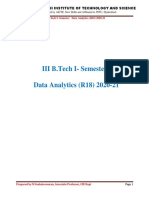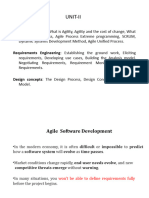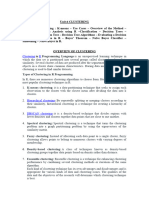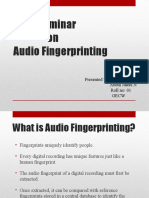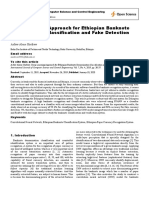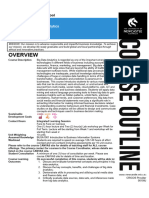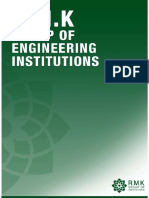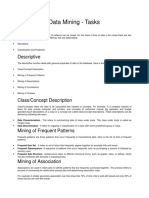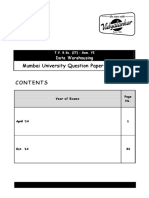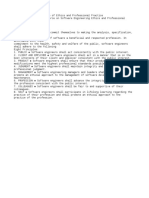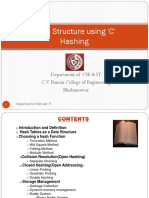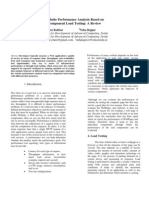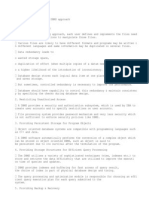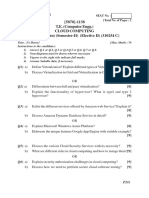0 ratings0% found this document useful (0 votes)
133 viewsInformation Retrieval 1 Introduction To IR
Information Retrieval 1 Introduction To IR
Uploaded by
Vaibhav KhannaThis document provides an introduction to information retrieval, covering early developments in libraries and indexing, the key goal of retrieving relevant information while limiting non-relevant results, and how users search by translating information needs into queries or browse collections. It discusses how IR has grown in importance with the rise of the web and digital libraries, and the basic components of an IR system including indexing, querying, and ranking results by relevance.
Copyright:
© All Rights Reserved
Available Formats
Download as PPTX, PDF, TXT or read online from Scribd
Information Retrieval 1 Introduction To IR
Information Retrieval 1 Introduction To IR
Uploaded by
Vaibhav Khanna0 ratings0% found this document useful (0 votes)
133 views12 pagesThis document provides an introduction to information retrieval, covering early developments in libraries and indexing, the key goal of retrieving relevant information while limiting non-relevant results, and how users search by translating information needs into queries or browse collections. It discusses how IR has grown in importance with the rise of the web and digital libraries, and the basic components of an IR system including indexing, querying, and ranking results by relevance.
Original Title
Information Retrieval 1 Introduction to IR.pptx
Copyright
© © All Rights Reserved
Available Formats
PPTX, PDF, TXT or read online from Scribd
Share this document
Did you find this document useful?
Is this content inappropriate?
This document provides an introduction to information retrieval, covering early developments in libraries and indexing, the key goal of retrieving relevant information while limiting non-relevant results, and how users search by translating information needs into queries or browse collections. It discusses how IR has grown in importance with the rise of the web and digital libraries, and the basic components of an IR system including indexing, querying, and ranking results by relevance.
Copyright:
© All Rights Reserved
Available Formats
Download as PPTX, PDF, TXT or read online from Scribd
Download as pptx, pdf, or txt
0 ratings0% found this document useful (0 votes)
133 views12 pagesInformation Retrieval 1 Introduction To IR
Information Retrieval 1 Introduction To IR
Uploaded by
Vaibhav KhannaThis document provides an introduction to information retrieval, covering early developments in libraries and indexing, the key goal of retrieving relevant information while limiting non-relevant results, and how users search by translating information needs into queries or browse collections. It discusses how IR has grown in importance with the rise of the web and digital libraries, and the basic components of an IR system including indexing, querying, and ranking results by relevance.
Copyright:
© All Rights Reserved
Available Formats
Download as PPTX, PDF, TXT or read online from Scribd
Download as pptx, pdf, or txt
You are on page 1of 12
Information Retrieval : 1
Introduction to IR
Prof Neeraj Bhargava
Vaibhav Khanna
Department of Computer Science
School of Engineering and Systems Sciences
Maharshi Dayanand Saraswati University Ajmer
Learning objectives of IR Series
• Introduction: Motivation, Basic concepts, past, present, and future, the retrieval process.
•
• Modeling: Introduction, A taxonomy of information retrieval models, retrieval: ad hoc and filtering, a formal
characterization of IR models, classic information retrieval, alternative set theoretic models, alternative
algebraic models, alternative probabilistic models, structured text retrieval models, models for browsing.
•
• Retrieval Evaluation: Introduction, retrieval performance evaluation, reference collections. query
• Languages: Introduction, keyword-based querying, Pattern matching, Structural queries, Query protocols.
•
• Query Operations: Introduction, user relevance feedback, automatic local analysis, automatic global analysis.
•
• Text and multimedia languages and Properties: Introduction, metadata, text, markup languages,
• Indexing and searching: Introduction; inverted files; other indices for text; Boolean queries; sequential
searching; pattern matching; structural queries; compression.
•
• Searching the Web: Introduction, challenges, characterizing the web, search engines, browsing, meta
searchers, finding the needle in the haystack, searching using hyperlinks.
Architecture of the IR System
Information Retrieval (IR)
• IR deals with the representation, storage, organization
of, and access to information items
• Types of information items: documents, Web pages,
online catalogs, structured records, multimedia objects
• Early goals of the IR area: indexing text and searching
for useful documents in a collection
• Nowadays, research in IR includes:
– Modeling, Web search, text classification, systems
architecture, user interfaces, data visualization, filtering and
languages.
Early Developments
• For more than 5,000 years, man has organized information for
later retrieval and searching
• This has been done by compiling, storing, organizing, and
indexing papyrus, hieroglyphics, and books
• For holding the various items, special purpose buildings called
libraries, or bibliothekes, are used
• The oldest known library was created in Elba, in the Fertile
Crescent, between 3,000 and 2,500 BC
• Since the volume of information in libraries is always growing,
it is necessary to build specialized data structures for fast
search — the indexes
Libraries and Digital Libraries
• For centuries indexes have been created manually as sets of
categories, with labels associated with each category
• The advent of modern computers has allowed the construction of
large indexes automatically
• Libraries were among the first institutions to adopt IR systems for
retrieving information
• Initially, such systems consisted of an automation of existing
processes such as card catalogs searching
• Increased search functionality was then added
• Ex: subject headings, keywords, query operators
• Nowadays, the focus has been on improved graphical interfaces,
electronic forms, hypertext features
IR at the Center of the Stage
• Until recently, IR was an area of interest restricted mainly to
librarians and information experts
• A single fact changed these perceptions—the introduction of
the Web, which has become the largest repository of
knowledge in human history
• Due to its enormous size, finding useful information on the
Web usually requires running a search
• And searching on the Web is all about IR and its technologies
• Thus, almost overnight, IR has gained a place with other
technologies at the center of the stage
The IR Problem
• The IR Problem
• The key goal of an IR system is to retrieve all
the items that are relevant to a user query,
while retrieving as few non relevant items as
possible
• That is, the IR system must rank the
information items according to a degree of
relevance to the user query
The User’s Task
• Consider a user who seeks information on a topic of their
interest
• This user first translates their information need into a query,
which requires specifying the words that compose the query
• In this case, we say that the user is searching or querying for
information of their interest
• Consider now a user who has an interest that is either poorly
defined or inherently broad
• For instance, the user has an interest in car racing and wants to
browse documents on Formula 1 In this case, we say that the
user is browsing or navigating the documents of the collection
The User’s Task
Information × Data Retrieval
• Data retrieval: the task of determining which
documents of a collection contain the keywords in the
user query Data retrieval system Ex: relational
databases
• Deals with data that has a well defined structure and
semantics
• A single erroneous object among a thousand retrieved
objects means total failure
• Data retrieval does not solve the problem of retrieving
information about a subject or topic
Assignments
• Briefly Discuss the Architecture of the IR
System
You might also like
- Module 3 - Computer Programming Development - Problem SolvingDocument77 pagesModule 3 - Computer Programming Development - Problem SolvingBukho TsengiweNo ratings yet
- Memory Based Reasoning - BIADocument19 pagesMemory Based Reasoning - BIAJayeeta Chatterjee100% (1)
- BI Lab ManualDocument9 pagesBI Lab Manualiamhafsa0% (1)
- 2.notes CS8080 - Information Retrieval TechniqueDocument164 pages2.notes CS8080 - Information Retrieval TechniqueThiyaga RajanNo ratings yet
- Data Warehousing and Data MiningDocument2 pagesData Warehousing and Data MiningdineshpadhiyarNo ratings yet
- Unit VDocument66 pagesUnit VBARATH100% (1)
- Unit #3 - Data Warehouse and Data MiningDocument70 pagesUnit #3 - Data Warehouse and Data MiningTanveer Ahmed HakroNo ratings yet
- OOSE SyllabusDocument2 pagesOOSE SyllabusSrikar ChintalaNo ratings yet
- Part I IR VTU M Tech SSEDocument72 pagesPart I IR VTU M Tech SSENatarajanSNo ratings yet
- ccs346 EdaDocument2 pagesccs346 Edakokila sadeesh1986No ratings yet
- Data Analytics Unit-IDocument25 pagesData Analytics Unit-I19524 AlekhyaNo ratings yet
- AI Unit 4 Lecture Notes ItDocument15 pagesAI Unit 4 Lecture Notes IttonyNo ratings yet
- Hive Lecture NotesDocument17 pagesHive Lecture NotesYuvaraj V, Assistant Professor, BCA100% (1)
- Enabling Technologies and Federated CloudDocument38 pagesEnabling Technologies and Federated Cloudasd100% (1)
- Ccs341-Question-Bank NNNNNNDocument10 pagesCcs341-Question-Bank NNNNNNmamithasuyambuNo ratings yet
- Se Unit2Document115 pagesSe Unit2kishoreNo ratings yet
- Irs Important QuestionsDocument3 pagesIrs Important QuestionsJaini Kavya0% (1)
- Unit IiiDocument23 pagesUnit Iiibhuvanachandra54No ratings yet
- Anna University Engineering Question BankDocument7 pagesAnna University Engineering Question BankJanaki JanNo ratings yet
- Modern System Analysis and DesignDocument41 pagesModern System Analysis and DesignNoratikah JaharudinNo ratings yet
- ISS Complete NotesDocument110 pagesISS Complete Notesprince Singh0% (1)
- Unit4 DatascienceDocument43 pagesUnit4 DatasciencedrsaranyarcwNo ratings yet
- Assignment # 01 Bscs - 7 Semester: Machine LearningDocument5 pagesAssignment # 01 Bscs - 7 Semester: Machine LearningPk Politic100% (1)
- Data Mining Lab ManualDocument2 pagesData Mining Lab Manualakbar2694No ratings yet
- For Seminar Presentation-Edited (Feb5)Document33 pagesFor Seminar Presentation-Edited (Feb5)SisieNo ratings yet
- Child Digital Monitoring and Controlling SystemDocument8 pagesChild Digital Monitoring and Controlling SystemVicky VickyNo ratings yet
- Software Engineering Chapter 5 PPT PressmanDocument22 pagesSoftware Engineering Chapter 5 PPT PressmanKhaja AhmedNo ratings yet
- Seminar On Audio Fingerprinting: Presented By: Abdul Jaleel.N Roll No: 01 GecwDocument19 pagesSeminar On Audio Fingerprinting: Presented By: Abdul Jaleel.N Roll No: 01 GecwarjunrajmpNo ratings yet
- System Analysis and DesignDocument4 pagesSystem Analysis and DesignRajashekhar B Beedimani100% (1)
- Deep Learning Approach For Ethiopian Banknote Denomination Classification and Fake Detection SystemDocument8 pagesDeep Learning Approach For Ethiopian Banknote Denomination Classification and Fake Detection SystemtilahunNo ratings yet
- Busa2001 2023 Sem2 NewcastleDocument6 pagesBusa2001 2023 Sem2 Newcastlevitoribeiro90No ratings yet
- Cns LessonplanDocument2 pagesCns LessonplanMikeSteveNo ratings yet
- B.tech 15CS326E Visualization TechniquesDocument5 pagesB.tech 15CS326E Visualization TechniquesRajalearn2 Ramlearn2No ratings yet
- Fundamentals of Data Science: Nehru Institute of Engineering and TechnologyDocument17 pagesFundamentals of Data Science: Nehru Institute of Engineering and Technologysakthisubi100% (1)
- Cognitive Computing (Course Code: 18CS3272) : CO1 - Session4 Session Topic: The Elements of A Cognitive SystemDocument9 pagesCognitive Computing (Course Code: 18CS3272) : CO1 - Session4 Session Topic: The Elements of A Cognitive SystemNeha ANo ratings yet
- IoT (15CS81) Module 5 Smart CitiesDocument9 pagesIoT (15CS81) Module 5 Smart CitiesRijo Jackson TomNo ratings yet
- Vtu 7TH Sem Cse/ise Data Warehousing & Data Mining Notes 10cs755/10is74Document70 pagesVtu 7TH Sem Cse/ise Data Warehousing & Data Mining Notes 10cs755/10is74EKTHATIGER63359094% (18)
- Recommender System SyllabusDocument3 pagesRecommender System SyllabusSri Karthik AvalaNo ratings yet
- Reg. No.:: Time: Three Hours Maximum: 100 Marks Answer ALL Questions Part - A (10×2 20 Marks)Document2 pagesReg. No.:: Time: Three Hours Maximum: 100 Marks Answer ALL Questions Part - A (10×2 20 Marks)Msec Mca100% (1)
- Object Detection ppt-1Document16 pagesObject Detection ppt-1Deeksha gowdaNo ratings yet
- Vu Re Lecture 16Document28 pagesVu Re Lecture 16ubaid ullahNo ratings yet
- Chapter One: Object Oriented ConceptsDocument36 pagesChapter One: Object Oriented ConceptsMehari TemesgenNo ratings yet
- Chapter 3 Cloud ApplicationsDocument15 pagesChapter 3 Cloud ApplicationsBrainy B. BrainNo ratings yet
- Data Mining & Data WarehousingDocument2 pagesData Mining & Data WarehousingSiva PratapNo ratings yet
- Oose Unit 3.2Document89 pagesOose Unit 3.2Shalu RenuNo ratings yet
- Uid-Graphical System AdvatagesDocument21 pagesUid-Graphical System AdvatagesSuganya NatarajanNo ratings yet
- Os Quetion BankDocument8 pagesOs Quetion BankAasai SNo ratings yet
- Classification & PredictionDocument78 pagesClassification & Predictionbiswanath dehuriNo ratings yet
- Cs3691-Unit 3Document22 pagesCs3691-Unit 3CS 4123- YashwanthNo ratings yet
- Cp4212 - Software Engineering Lab ManualDocument46 pagesCp4212 - Software Engineering Lab ManualPrakash JeevaNo ratings yet
- CS8792 CNS Unit 1 - R1Document89 pagesCS8792 CNS Unit 1 - R1Loner VishalNo ratings yet
- Data Mining - Tasks: Data Characterization Data DiscriminationDocument4 pagesData Mining - Tasks: Data Characterization Data Discriminationprerna ushirNo ratings yet
- CCS341 Data Warehousing Notes Unit IDocument30 pagesCCS341 Data Warehousing Notes Unit IsobiyaparasuramanNo ratings yet
- Mumbai University Question Paper Solutions: Data WarehousingDocument58 pagesMumbai University Question Paper Solutions: Data WarehousingPramod BhusareNo ratings yet
- Lab 1: Preprocessing Using PythonDocument5 pagesLab 1: Preprocessing Using PythonPF 21 Disha GidwaniNo ratings yet
- Software Engineering PreambleDocument1 pageSoftware Engineering PreambleJayvee ColiaoNo ratings yet
- Data Warehousing & Data Mining Syllabus Subject Code:56055 L:4 T/P/D:0 Credits:4 Int. Marks:25 Ext. Marks:75 Total Marks:100Document52 pagesData Warehousing & Data Mining Syllabus Subject Code:56055 L:4 T/P/D:0 Credits:4 Int. Marks:25 Ext. Marks:75 Total Marks:100hanmanthNo ratings yet
- Query Languages and Query Operation: Chapter SevenDocument20 pagesQuery Languages and Query Operation: Chapter Sevenmilkikoo shiferaNo ratings yet
- Data Structure Using 'C' Hashing: Department of CSE & IT C.V. Raman College of Engineering BhubaneswarDocument55 pagesData Structure Using 'C' Hashing: Department of CSE & IT C.V. Raman College of Engineering BhubaneswardeepakNo ratings yet
- Rapid Application Development A Complete Guide - 2019 EditionFrom EverandRapid Application Development A Complete Guide - 2019 EditionNo ratings yet
- Information Retrieval 8 Term Weighting ADocument11 pagesInformation Retrieval 8 Term Weighting AVaibhav KhannaNo ratings yet
- Information Retrieval 7 Boolean ModelDocument11 pagesInformation Retrieval 7 Boolean ModelVaibhav KhannaNo ratings yet
- Information Retrieval 6 IR ModelsDocument14 pagesInformation Retrieval 6 IR ModelsVaibhav KhannaNo ratings yet
- Information Retrieval 3 Query Search InterfacesDocument13 pagesInformation Retrieval 3 Query Search InterfacesVaibhav KhannaNo ratings yet
- Mds (Medicine Donation System) : Bachelor of Science in Computer ScienceDocument77 pagesMds (Medicine Donation System) : Bachelor of Science in Computer ScienceMubashir hussainNo ratings yet
- Website Performance Analysis Based On Component Load Testing: A ReviewDocument6 pagesWebsite Performance Analysis Based On Component Load Testing: A Reviewsurendiran123No ratings yet
- XpediterDocument2 pagesXpediternithyasumeshNo ratings yet
- Automatic Workload RepositoryDocument9 pagesAutomatic Workload RepositoryBeaNo ratings yet
- MongoDB Reference Manual MasterDocument1,161 pagesMongoDB Reference Manual MasterRian MagsNo ratings yet
- Approval and QC TemplateDocument7 pagesApproval and QC TemplateOkka PratamaNo ratings yet
- Cp5005 Sqat LsDocument3 pagesCp5005 Sqat LsKeerthi KaNo ratings yet
- E-Commerce Furniture Website Using PHP: Submitted To: Mr. Pankaj DhakalDocument23 pagesE-Commerce Furniture Website Using PHP: Submitted To: Mr. Pankaj DhakalSimran Shrestha100% (1)
- Software Requirements Specification: Version 1.0 ApprovedDocument16 pagesSoftware Requirements Specification: Version 1.0 ApprovedAbdul Rehman ButtsarkarNo ratings yet
- Fingerprint DeobfuscationDocument8 pagesFingerprint DeobfuscationSamuelNo ratings yet
- Advantage of Database ApproachDocument2 pagesAdvantage of Database ApproachArup Kumar BoroNo ratings yet
- Dottie Blyth: Education SkillsDocument1 pageDottie Blyth: Education SkillsDottieNo ratings yet
- Az 120 FullDocument258 pagesAz 120 FullDung NguyenNo ratings yet
- Software Engineer MCQSDocument68 pagesSoftware Engineer MCQSsabiha kamranNo ratings yet
- 3630002Document4 pages3630002jagNo ratings yet
- CC (Paper 1)Document2 pagesCC (Paper 1)Shruti GenganeNo ratings yet
- Accedian SkyLIGHT Value PropositionDocument44 pagesAccedian SkyLIGHT Value PropositionBenny LimNo ratings yet
- IV Yr II Sem Lesson PlansDocument19 pagesIV Yr II Sem Lesson Plansbagaverupesh8No ratings yet
- Anusha1report FinalDocument28 pagesAnusha1report FinalGoutam NaikNo ratings yet
- Spau and SPDD: Technical Upgrade Functional UpgradeDocument4 pagesSpau and SPDD: Technical Upgrade Functional Upgradepuneet mittalNo ratings yet
- Aleaud Acknowledgments With Idoc - Aae Adapter 1Document7 pagesAleaud Acknowledgments With Idoc - Aae Adapter 1JagadishBabu ParriNo ratings yet
- Aakash's Resume PDFDocument1 pageAakash's Resume PDFAbhinav GargNo ratings yet
- Quiz 5 Answers PDFDocument10 pagesQuiz 5 Answers PDFAnkit FalduNo ratings yet
- Software Engineer: Rajiv MaharjanDocument2 pagesSoftware Engineer: Rajiv MaharjanLikesh ShresthaNo ratings yet
- Oralcee Apps NotesDocument256 pagesOralcee Apps NoteskotturvNo ratings yet
- Top 50 CSS & CSS3 Interview Questions & AnswersDocument9 pagesTop 50 CSS & CSS3 Interview Questions & AnswersNIMESH KUMARNo ratings yet
- Semaphore BasicsDocument6 pagesSemaphore Basicsjoshi.prahaldNo ratings yet
- X5 Oracle Database Applianc Oracle Database Appliance e X5 2Document5 pagesX5 Oracle Database Applianc Oracle Database Appliance e X5 2Carlos BritezNo ratings yet
- 03 - Power BI CI-CD With Tabular EditorDocument16 pages03 - Power BI CI-CD With Tabular EditorAmarnath Reddy KohirNo ratings yet
- Fuzz Testing (Fuzzing) Tutorial - What Is, Types, Tools & ExampleDocument8 pagesFuzz Testing (Fuzzing) Tutorial - What Is, Types, Tools & ExampleanchalNo ratings yet










